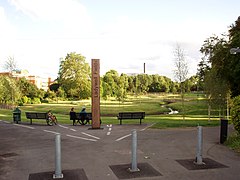|
Ladywell
 Ladywell is a locale in Lewisham in South East London, England, and a ward in the London Borough of Lewisham between Brockley, Crofton Park and Lewisham proper. It has ample green space including Ladywell Fields and Hilly Fields which borders Brockley. Ladywell Village, the main shopping area along Ladywell Road, was given a facelift in 2013 with £800,000 of Transport for London funding. The pavements were widened, short stay bays created to help local businesses and shoppers, and trees were added. Ladywell Village has a range of retail outlets including a number of cafes, a patisserie and a delicatessen. HistoryThe name Ladywell was in use by the 15th century, and maps dating to this period show the site of the original Lady well, in front of the area later to be occupied by the Freemason's Arms and now marked by a plaque.  The well was probably a holy well dedicated to Virgin Mary and was 1.8 m to 2 m (six to seven feet) deep and surrounded by an iron railing. It was in use until the 1850s, when it was covered over as part of the construction of the railway. The coping stones of this well were later uncovered during work to underpin the railway bridge, and rescued by a signalman. In 1896 they were incorporated as part of the fountain that stood in the grounds of the Ladywell Public Baths, a local landmark built in red brick in 1884.[2] Another well is located nearby at what is now 148 Ladywell Road. This was a mineral spring, the waters of which local people drank for medicinal purposes. Until the second half of the eighteenth century there were few dwellings in Ladywell, the most notable being 'The Bridge House Farm' and Ladywell House. Ladywell House was the vicarage built in 1693 for Dean George Stanhope, the vicar of Lewisham and Deptford.[3] Stanhope was a friend of the writer Jonathan Swift,[4] Swift visited Ladywell House in 1711.[5] The house was extended in 1881 and 1895, and is now used by the South London and Maudsley NHS Foundation Trust. The opening of Ladywell Station in 1857 brought expansion to the area. Church Grove and the terraces to either side of it in Ladywell Road were built in the following year, which also saw the opening of Ladywell Cemetery, Railway Terrace, Prospect Place, and Mercy Terrace. The public park Ladywell Fields opened in the 1890s. Hilly Fields park opened on 16 May 1896 after campaigning by one of the Founders of the National Trust,Octavia Hill.[6] Conservation areaDesignated in 2010, the area consists mainly of late Victorian suburban residential development which was built by the local developer Samuel J. Jerrard. In the conservation area, external changes to elevations visible from public viewpoints require planning permission. These include:
Through the 1880s and 1890s Jerrard built up long stretches of Vicars Hill and the newly laid out streets Algernon Road, Algiers Road, Ermine and Embleton Road, taking advantage of the topography and the good transport links to London. His houses are generously sized and are stylistically distinctive as a group. Many of his other houses in the area are protected within the Brockley conservation area. Jerrard’s development in Ladywell survives nearly complete, including its rich architectural detailing. It constitutes the core of the conservation area, supplemented by some later infill development of the late 19th and early 20th century that completed his streets. The conservation area also encompasses the commercial core of Ladywell along Ladywell Road, known as Ladywell Village, which contains some of the oldest houses and pubs of the area and Edwardian shops that were constructed at the turn of the century in response to the rapidly increasing community around them. The Council recommends a number of improvements that could be made to the benefit of both the character of the area as well as the value of individuals’ properties:
Local PoliticsLadywell is a ward of Lewisham Council, represented by three councillors who are elected every four years.
Gallery
Notable people
Local societiesThere are two local societies. The Ladywell Village Improvement Group and the Ladywell Society TransportLadywell station itself is on Southeastern's Hayes Line with direct trains to Elmers End, Hayes, London Bridge, Cannon Street, Waterloo East and Charing Cross. It has been proposed to extend the Bakerloo line to Ladywell[7] Other close stations: Nearest placesReferences
External links |
||||||||||||||||||||||||||||||||||||||||||||||||||||||||||||||||||||||||||||||||||||||||||||||||||||||||||||||||||||||||||||||||||||||||||||||||||||||||||||||||||||||||||||||||
Portal di Ensiklopedia Dunia












